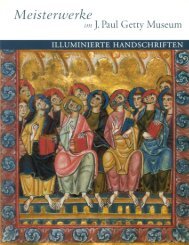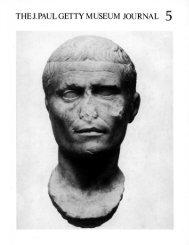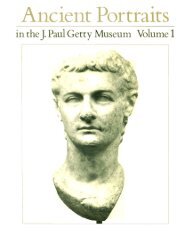The J. Paul Getty Museum Journal Volume 15 1987
The J. Paul Getty Museum Journal Volume 15 1987
The J. Paul Getty Museum Journal Volume 15 1987
You also want an ePaper? Increase the reach of your titles
YUMPU automatically turns print PDFs into web optimized ePapers that Google loves.
30 VermeuleFigure 3a. Votive basin. Greek, circa 320—280 B.C. Marble. H (max.): 30.8 cm (1276"); Diam (max. including handles): 60 cm(237s"), (max. at rim): 56 cm (22"). Malibu, <strong>The</strong> J. <strong>Paul</strong> <strong>Getty</strong> <strong>Museum</strong> 85. AA.107.body and its silly griffin looking like a puppy beggingfor a biscuit, this Apollo shows its originality by incorporatingonly those "Archaizing" elements, notably thecoiffure, necessary to identify the statue as a modern(fourth century B.C.) restyling of a venerable imagewith no attempts at academic imitation.TABLE SUPPORT: TWO GRIFFINS ATTACKING AFALLEN DEER<strong>The</strong> two griffins crouch over their fallen prey, a deer,on a rough base similar to those used for Attic funeraryanimals in the fourth century B.C. (figs. 2a—b). <strong>The</strong>curling "Ionic," or traditionally East Greek, wings aresolid between, each having a large, rectangular andhorizontal slot and a vertical groove on the facing, innersurface. This arrangement was probably designed for ametal or wooden support for the table top, which restedon the curling upper surfaces of these wings. 7<strong>The</strong> high quality of the carving and the stylistic detailsof the animals, notably the eye treated as a raisedcircle or half a ball, all indicate a date of executionwithin the period of the last Athenian funerary beasts,which extended from around the time of Alexander theGreat's death to the second decade of the third centuryB.C. For the functional use of these griffins and the deeras part of a piece of furniture, however, we have to seekparallels in the best decorative carving of the periodaround 80 B.C. and later, when so many more monumentalmarble tables and their components survive. 8Evidence from Pompeii and Herculaneum confirms thatelaborate tables in marble or metal had their places inthe homes of the wealthy, but they were also definitely7. Accession number 85.AA.106. H (max. at top of wings): 95 cm(37 7 he"); W (max. at plinth): 20 cm (7 7s"), (at top of wings): 22 cm(8W); L (max.): 148 cm (58V 2").Crystalline Greek island marble. <strong>The</strong>re are numerous breaks carefullymended with small pieces attached but with no restorations.Many traces of the red, blue, and golden brown colors survive—towit, the blue for the griffins' wings, bright red for the griffins' combs,brown or fawn color for the fallen quadruped, red also for the bloodaround the mouths of the griffins and the areas where their claws havedug into the unfortunate beast. <strong>The</strong> eyes of the griffins and especiallytheir eyeballs had brown underpainting, and the fallen animal's eyeswere red. <strong>The</strong> plinth is roughly finished; the griffins' bodies are thesmoothest parts of the sculpture. See "Acquisitions/1985," <strong>The</strong> J. <strong>Paul</strong><strong>Getty</strong> <strong>Museum</strong> <strong>Journal</strong> 14 (1986), no. 4, p. 180.8. This ensemble has also been published, without illustration, bythe writer in "Bench and Table Supports: Roman Egypt and Beyond,"Studies in Ancient Egypt, the Aegean, and the Sudan: Essays in Honor ofDows Dunham on the Occasion of His 90th Birthday, June 1, 1980, ed. W.








